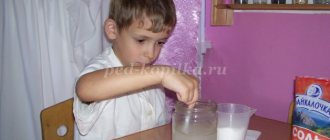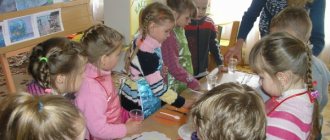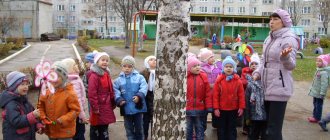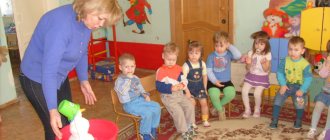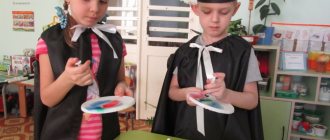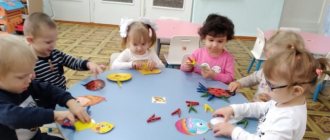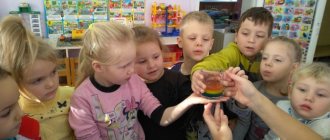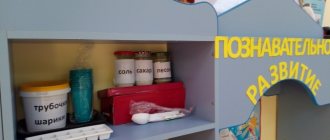CHILDHOOD GUIDE
One of the areas of cognitive development of preschoolers is the formation of their natural scientific ideas about the world around them. It is recommended to begin work in this area purposefully and systematically from early preschool age. It is during this period that the foundation of a conscious attitude towards the world around us is laid, and vivid emotional impressions are accumulated.
The tasks of forming the cognitive and research activities of children of the younger group: - to develop the ability to establish the simplest connections and relationships to objects in the immediate environment; — enrich the knowledge of preschoolers with new impressions; - promote the development of cognitive interest in the world around us.
Approximate thematic planning of cognitive and research activities with children of the younger group
The work is carried out during observations on walks, during games-experiments with natural materials or in the form of role-playing games, in independent activities of children.
1. Our square. Tasks and content: Consider autumn trees: rowan, birch. Identify the characteristic features - on birch they are small and round, on rowan they are large and long, oblong. 2. Gifts of autumn. Tasks and content: Observing the movement of air - the wind blows and tears leaves from the trees, the leaves swirl in the air. Collect bouquets of colorful leaves. You can offer to throw bouquets up “let’s make fireworks.” Admire the multi-colored carpet that has formed on the ground. 3. Let's walk on a carpet of leaves. Objectives and content: Continue to form the concept that with the arrival of cold weather, leaves dry out, fall from the trees and rustle underfoot. Walk on a rustling mat of dry leaves. Tell that the wind also knows how to play with dry leaves. Listen to the wind rustle the leaves. 4. Decorate the sandbox with autumn leaves. Objectives and content: Reinforce in children the names of primary colors: green, yellow, red. Continue to form the concept of the size of a “big-small” leaf in the process of laying out a pattern of multi-colored leaves. 5. Experimental game: “Drowning - not drowning.” Objectives and content: Determine the degree of buoyancy of objects of different weights. The leaves are light - they float like boats. Check if the stones will float? Find out the cause-and-effect relationship. 6. Gifts of autumn. Tasks and content: Reinforce the name of the main colors of autumn leaves. Make a garland of leaves and decorate the group. 7. Experimental game: “Which boat is faster?” Objectives and content: Observation of the strength and work of the wind. Make boats from leaves and paper. Find out together with the children which boat the wind will carry away further - from a piece of paper or from paper? 8. Journey of a droplet. Objectives and content: To reinforce the signs of autumn in children: when it rains, the paths become wet, damp, and there are puddles on the ground. Pay attention to the size of the puddles: large and small. 9. Let's build a slide from loose sand. Objectives and content: Introduce the concept of “loose”: slowly pour sand into a cone and watch how the grains of sand fall down. 10. Sand can run. Objectives and content: To introduce children to the properties of dry sand - it “runs” down, “slides” from a height. Take dry sand in your hands and slowly release it from the fist in a stream, so that the stream of sand falls in one place. A hillock is formed. Watch the sand slowly run down from the top. 11. Footprints in the sand. Objectives and content: Explain to children that wet sand leaves footprints. Damp sand does not fall. Traces from the mold remain on the wet sand. And the palm leaves a mark, and the shoe, and the boots. 12. Let's see grains of sand. Objectives and content: Introduce children to a magnifying glass. Tell that sand consists of individual grains of sand, they can be seen, the grains of sand are different in shape and size. 13. We sculpt from wet sand. Objectives and content: To introduce children to the peculiarity of wet sand: it molds, but dry sand does not. Invite the children to make large and small koloboks. 14. Gifts from our forest. Objectives and content: Introduce the fruits of the forest. Consider the structure of spruce and pine cones. Compare leaves and cones of spruce plants. 15. Gifts from our site. Such different stones. Objectives and content: Reinforce the concept: heavy and light. Invite the children to find pebbles in the sandbox and examine them: they are all different, large and small, round and oblong. Check which pebble will sink faster: big or small? 16. Gifts from our site. Such different stones. Objectives and content: Reinforce the concept: wet - dry. Invite the children to find pebbles in the sandbox and put them in a bucket of water. Find out what happened to them. What kind of stones did they become? 17. Colored droplets. Objectives and content: Find out with children the properties of water. Show children that water can have colors. Using a brush or pipette, tint the water to create different colors. 18. Such different dishes. Objectives and content: Show children that dishes are made of various materials: metal, clay, wood, plastic, glass. Consider various examples of tableware. Prove that the dishes are fragile and may break. 19. Secrets of different rings. Objectives and content: To introduce children to rings of various shapes and sizes (car wheels, bagels, dryers). Conduct examinations and experiments with dough or plasticine. 20. Such different patterns. Objectives and content: Examine frost patterns on glass with children. Offer to breathe on the glass, place your palm on the glass. 21. Gifts of winter. Footprints in the snow. Tasks and content: Observe freshly fallen snow. Examine the footprints in the snow, offer to guess who came to the site? Who left the path? (bird, dog, person). 22. Such different koloboks. Objectives and content: Draw children’s attention to the fact that snow melts in warmth. Add 2 lumps of dough and snow, place in a warm place. After the walk, check what happened to them? Where did the snowball go? 23. Gifts of winter. Magic ice floes. Tasks and content: Observe water in the cold. Find out that water turns into ice in cold weather. Take the molds out to the area and fill them with colorful water. Watch what happens? Decorate the area with multi-colored ice floes. 24. Gifts of spring. Funny icicles. Objectives and content: Prove that when snow melts, icicles form under roofs. Examine them: transparent, slippery, like glass. Hold pieces of icicles in your palms. Find out that a warm palm will melt an icicle. 25. Gifts of spring. Happy streams. Objectives and content: To introduce children to the signs of spring. The warm sun melted the snow and turned into streams. Play the game - launch a paper boat into a stream. 26. Big wash. Objectives and content: Find out with the children that not everything can be washed in water. Offer to wash the dress for Katya doll. First a dress made of fabric, and then a dress made of paper. Analyze the result. 27. Games with soap foam. Objectives and content: Show children that soap foams. Learn how to whip foam. Hold a competition to see who can make the foam higher and fluffier. 28. Guests of our yard. Tasks and content: Observe the dog. Find out what food she eats, how she runs, and wags her tail. 29. Guests of our yard: Who flew to the site? Objectives and content: Conduct bird observation. Find out the characteristic features of pigeons and sparrows. 30. Guests of our yard. Our cat. Objectives and content: Observing the habits and behavior of the cat. What can a cat do? (Play, walk, run, purr, sleep, squint in the sun). What food does she eat? 31. Gifts of spring. Sunny bunnies. Objectives and content: Play a game with a mirror. “Catch” a sunbeam, bring pleasure to children, evoke positive emotions. 32. Our aquarium. Objectives and content: To introduce the habitat of aquarium fish. Consider the appearance of the fish. Tell us how to care for fish. 33. Our garden. Tasks and content: Plant vegetables and herbs with the children. See what grows faster? Find out the necessary conditions for the growth of vegetables.
Dear teachers! If you have questions about the topic of the article or have difficulties in working in this area, then write in the comments. I'll definitely help.
Golovina Bela Gennadievna, site administrator. Planning cognitive and research activities in the middle group of a preschool educational institution Planning of cognitive and research activities in the senior group of a preschool educational institution The importance of theatrical and gaming activities in the second junior group Role-playing games in the second junior group of a preschool educational institution >
Lesson on cognitive and research activities in the second junior group of kindergarten
Children 3–4 years old have an inquisitive mind; they can be interested in any subject in any situation, spontaneously. It is important for the teacher to notice such moments during the children’s independent activities in order to include them in joint research work. Elements of experimentation with younger preschoolers are used during classes on the surrounding world (“Orange, its features,” “What is snow”), during creative classes (“Mixing colors,” “Learning to sculpt from clay”), musical (“How do they sound?” metal, clay, porcelain bells"), etc. Observations on walks occupy a special place.
In the process of carrying out research activities, the teacher helps younger preschoolers at every stage of work. Speech accompaniment of all actions during experimentation is required (in the senior and preparatory groups, children will begin to pronounce their actions while the teacher does it for them). The teacher uses the direct demonstration method for the entire group and, if necessary, additionally for those children who have difficulties in performing the experiment.
During the experimentation process, the teacher talks through everything that is happening.
Children should not perceive research activities as specific work. The teacher does not prepare them for the profession of a scientist in the future, but teaches them exciting and effective ways to understand the world around them.
When constructing the practical part, the teacher takes into account the age characteristics of younger preschoolers. One research procedure can be divided into several separate stages. The learning process can be interrupted to prevent fatigue (playing and sports exercises, a musical break).
Table: forms of organizing research activities with children 3–4 years old
| Criteria for organizing research | Research forms |
| By the nature of the research objects |
|
| At the location of the experiment |
|
| Due to research |
|
| By the number of children participating in the experiment |
|
| By duration |
|
| By the nature of cognitive activity |
|
| By place in the cycle of educational activities |
|
| By the degree of inclusion in the educational process |
|
| By the nature of mental operations |
|
Card file of topics on research activities in the second junior group
| Research topic | Research objectives |
| "Sand and its properties" | Formation of ideas about sand, its properties in various states (dry and wet). |
| "What is the wind" | Learning the skills to study intangible objects using special instruments (to study the properties of wind you will need pinwheels, flags, nets, and a weather vane). |
| "Sun" | Expanding knowledge about the sun, the properties of its light and heat. |
| "Bubble" | Expanding knowledge about the properties of air. |
| "Stones" |
|
| "Fruits" | Learning to characterize the object of study in different aspects (lemon: by color - yellow, by smell - pleasant, aromatic, by taste - sour, by tactile sensation - smooth with small pimples, etc.). |
| "We are explorers" |
|
| "Snow and Ice" | Introducing children to the solid state of water, its characteristics, and the conditions for returning to the liquid state. |
| "Water and its properties" |
|
| "What smells?" | Developing children's sensory experience through smell. |
| "Roll, balls" |
|
| "Clay" |
|
| "Shadow" | Expanding knowledge about the ability of objects to cast shadows. |
| "The soil" | Formation of ideas about the soil (what it consists of) and its properties (it heats up, absorbs water, serves as a nutrient medium for plant growth). |
| "Paper boat" | Expanding knowledge about the properties of paper. |
| “Why do the buds bloom?” |
|
| "Chalk and Coal" | Formation of the ability to compare materials by properties and qualities. |
| "Drowning - not drowning" | Acquaintance with the ability of water to push objects made of rubber, plastic, wood, and foam. |
Motivating start to classes
Classes on cognitive activities with pupils of the younger group should be bright. A high level of curiosity and emotionality allows a preschooler to fill his long-term memory with images that impress him. How interested and involved the child is in the educational process at the beginning of the lesson depends on his activity during direct research activities, the result of solving the problem posed and the degree of motivation for experimentation in the future. The teacher needs to use a variety of forms for conducting the initial stage of the lesson, which will add variety to the usual activities of preschoolers.
Demonstration of the research object will help to arouse children’s interest at the beginning of the lesson.
Table: examples of a motivating start to a lesson
| Cognitive Research Topic | Option for a motivating start to the lesson |
| Forming children’s ideas about the properties of ice (lesson “Releasing beads from ice”) | Creating a surprise moment with a problematic situation. A Dymkovo toy comes to the group (in the role of a Dymkovo young lady - a pupil of the preparatory group, a senior teacher or another employee of the preschool educational institution by agreement), she is upset and complains to the children. The toy was invited to visit by a young lady she knew; she was in a hurry to have a friendly tea party and caught her beads on a branch in the winter forest. The thread broke and the beads scattered. The toy has collected them, but cannot string them on a thread because the beads are covered with ice (shows the children ice cubes with beads in the middle brought in a bowl). The guys will have to find a way to remove the beads so that the Dymkovo young lady can repair the jewelry and have time for a visit. |
| Introducing children to the properties of sand (lesson “Secrets of Sand”) | Game motivation. A fairy-tale guest is waiting in the group of children (it could be Aladdin, Dunno, etc.), he reports that he has arrived from the land of sands. The guest talks with the children (do they know what sand is, where they saw it, how they played with it), shows photographs of a wonderful country. He reports that he is ready to teach the children new games with sand, which the inhabitants of the land of sands love so much. |
| Formation in children of elementary ideas about how soap bubbles are made (lesson “How to make soap bubbles?”, preparation for the event “Bubble Festival”) |
|
| Cognitive development of children, working with flour and dough (integrated lesson “Wonderful Flour”) | Creating a game situation based on the previously studied fairy tale “Masha and the Bear”. At the beginning of the lesson, the teacher informs the children that near the garden she met a bear from a fairy tale: Everyone sit down in a row, Let's play nicely! Get your ears and eyes ready, let's begin our fairy tale. Today I came to the garden and found a roar bear. Mishka cried near the garden: “I want to go to kindergarten, to the kids!” Then the teacher asks what is the reason for the bear’s sadness (a plush toy can be used as a bear, or it is possible for a student in the senior group to play the role of a bear). Mishka says that Mashenka sent him to take the pies to his grandfather and grandmother, and he ate them on the way and is now sad that he violated the girl’s ban on not sitting on a tree stump and not eating the pie. The guys will help the bear by studying the characteristics of flour and methods of preparing and modeling dough (in class - from salt dough). |
Table: fragment of the lesson notes “Introducing children to search-cognitive activities” in the second junior group (using the example of the topic “Water”)
| Author | Telgina O., teacher at Moscow Children's Educational Institution No. 24, Novotroitsk, Orenburg region. |
| Lesson objectives |
|
| Equipment |
|
| Progress of the lesson | V.: Guys, look how many guests we have, let's say hello to them. Now look at me everyone. We will play with you. One, two, three, everyone look at me! (Teacher dressed as Moidodyr). Guys, you recognized me. Who am I? (Children's answers).
Guess my riddle and play with the answer.
The teacher invites the children to get to know the water better. The guys study what sounds water makes, what color, smell, and taste it is. <…> V.: And now our magic continues. Let's add some paint to our cups and then see what we get. (Carry out an experiment). What kind of water has it become? Is anything visible through it? (Children's answers). Well done boys! Now let's play. Physical exercise “Drops”.
Q: Guys, do you know why we need water? (Wash, bathe, cook, do laundry, etc.). Well done, guys. Who needs water? (Fish, birds, animals, plants). Oh, guys, look what kind of bottles we have. Yes, they are with water! Let's go and see why they are standing aside? How many are there? (A lot of). Are they the same? (Yes, they are all small, the same color). How are they different? Let’s touch them with our hands. (Children touch bottles with cold, hot and warm water in turn). How are these bottles different? (Children's answers). How did you know what kind of water was in the bottles? (Touched with hands). Why do we need hot water? (Drink tea, eat soup, wash dishes, swim). Guys, why do you think we need warm water? (Wash, wash clothes, brush your teeth, etc.). Why do we need cold water? (Drink water, rinse clothes). Do you know what happens to water if you put it in the cold? Let's pour water into the molds and ask Svetlana Vladimirovna to take it out into the cold and see what happens. Are you interested in playing with me? (Children's answers). Questions for reflection:
V.: Look, guys, Svetlana Vladimirovna brought us our molds. What happened to the water? (Children's answers). Yes, that's right, the water froze. Water is not only liquid, but also solid. What a magic water! Well done kids, you did a great job today! Now one, two, three, everyone look at me. Now let's say goodbye to the guests and go for a walk and play. |
| Quote from: https://www.maam.ru/detskijsad/konspekt-zanjatija-na-temu-oznakomlenie-detei-s-poiskovoi-poznavatelnoi-dejatelnostyu-po-teme-voda-vtoraja-mladshaja-515502.html | |
Temporary lesson plan for the younger group
The duration of an educational lesson in the second junior group, according to SanPiN standards, is 15 minutes. The lesson should have a clear structure, including various types of activities. Since cognitive and research activities require mental effort, such classes should be conducted in the first half of the day, preferably on Tuesday or Wednesday - days of high performance. In the afternoon, it is possible to organize a circle for experimental activities and conduct short-term observations on evening walks.
To avoid overtiring of children, educational and research activities are conducted in the first half of the day.
Approximate time plan for a lesson on cognitive and research activities in the second junior group:
- Organizational moment - 1 minute.
- Motivating start of the lesson - 3 minutes.
- Constructing a research plan, talking through the stages of the experiment with the guys - 2 minutes.
- Physical activity (exercises, finger exercises, outdoor play) - 2 minutes.
- The practical part of the work is 6 minutes.
- Formulation of research results, summing up – 1 minute.
Table: examples of temporary lesson plans
| Lesson topic | Organizing time | Motivating start to class | Constructing and speaking a research plan | Physical activity | Practical work | Summarizing |
| “Why does the icicle cry in the spring?” | 1 minute. | Creating a problematic situation. The group receives a letter from the Snow Queen, in which she reports that the icicles on the roof of her palace have begun to melt. She asks the guys to find out the reason for the melting. 3 minutes. | 2 minutes. | Outdoor game "Snowflakes". 2 minutes. | Conducting an experiment to observe the melting of ice. 6 minutes. | 1 minute. |
| "Clay and its properties" | 1 minute. | Conducting a conversation on the topic “Clay toys” with viewing the exhibition. 2–3 minutes. | 1–2 minutes. | Finger gymnastics “I play with toys.” 2 minutes. | Conducting research on clay material. 6 minutes. | 1 minute. |
| "Drowning - not drowning" | 1 minute. |
3 minutes. | 1 minute. | Physical education 2 minutes. | Conducting an experiment with a ball and water. 6 minutes. | 1 minute. |
Junior group. Early childhood, nursery. Children 1-4 years old
Summary of educational activities on FEMP with children 3–4 years old in the general developmental group “Research and experimentation “Properties”” Purpose: To show children that, in addition to sensory perceived signs, objects have properties that manifest themselves when they interact with each other. Objectives: To consolidate the ability to identify the properties of objects. Develop logical thinking. Activate the dictionary. Cultivate interest...
Summary of educational cognitive and research activities with children 3–4 years old “Magic Snow” MBDOU “Kindergarten”
Sun" Vuktyl 2022
Summary of educational cognitive and research activities with children 3-4 years old "Magic Snow"
Compiled by: Educator of the 1st category: Tumina O.P.
Type of activity : integrated (
cognitive-research , gaming) ...
